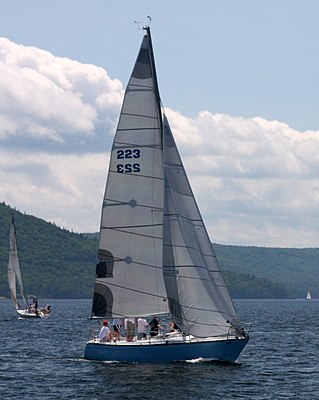
The Tartan Ten, also called the Tartan 10, is an American sailboat that was designed by Sparkman & Stephens as a one-design racer and first built in 1978.

The Com-Pac 16 is an American trailerable sailboat that was designed by Clark Mills as a small cruiser and first built in 1972.
The Swan 371 is a Finnish sailboat that was designed by Ron Holland for racing and first built in 1979.

The Bluejacket 23 is a 23-foot (7.0 m) Canadian trailerable, fibreglass monohull sailboat designed by Cuthbertson & Cassian as a day sailer and club racer and first built in 1967.
The Hunter 320 is an American sailboat that was designed by the Hunter Design Team and first built in 2000.
The Hunter 466 is an American sailboat that was designed by the Hunter Design Team as a cruiser and first built in 2002.
The Hunter HC 50 is an American sailboat that was designed by the Hunter Design Team as a "long distance express cruiser" and first built in 2000.
The Cal 2-25 is an American sailboat that was designed by C. William Lapworth as a cruiser-racer and first built in 1977.
The Cumulus 28, also called the Albin Cumulus, is a Swedish sailboat that was designed by Peter Norlin as a cruiser-racer and first built in 1978.
The Allmand 31 is an American sailboat that was designed by Walter Scott as a cruiser and first built in 1978.
The Baltic 37 is a Finnish sailboat that was designed by Robert W. Ball and C&C Design as an International Offshore Rule (IOR) racer-cruiser and first built in 1978.
The Baltic 40 is a Finnish sailboat that was designed by Judel/Vrolijk & Co. as an International Offshore Rule racer-cruiser and first built in 1988.
The Nordic 40 is an American sailboat that was designed by Robert Perry as a racer-cruiser and first built in 1978.
The Nimbus 42 is a Swedish sailboat that was designed by Americans F. Michael Kaufman and Robert Ladd as a cruiser-racer and first built in 1981.
The Vagabond 17 is an American trailerable sailboat that was designed by Ron Holder as a pocket cruiser and first built in 1976.

The Shipman 28, also sold as the Baltic 28, is a Swedish sailboat that was designed by Olle Enderlein as a cruiser and first built in 1969.
The Jeanneau Love Love is a French trailerable sailboat that was designed by Philippe Harlé as a coastal cruiser and first built in 1971.
The Espace 620 is a French trailerable sailboat that was designed by the Jeanneau Design Office as a cruiser and first built in 1983. The boat is part of the Espace series of cruising sailboats and its designation indicates its length overall in centimeters.

The Little Harbor 44 is an American sailboat that was designed by Ted Hood and first built in 1983.
The Sun Odyssey 509 is a French sailboat that was designed by Philippe Briand as a cruiser and first built in 2011.








